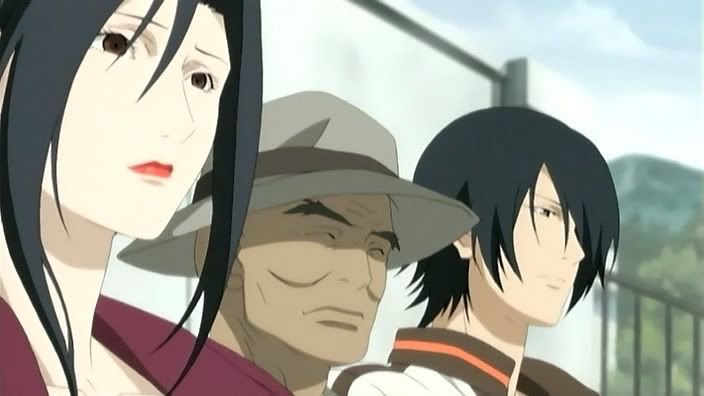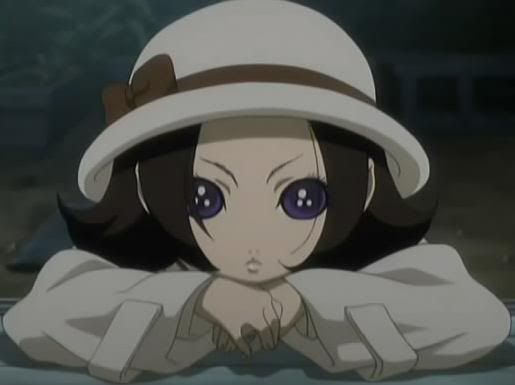Hell Girl: Two Prisoners (Jigoku Shoujo: Futakomori)

Title: Jigoku Shoujo: Futakomori (Hell Girl: Two Prisoners - Translated Title)
Rating: 3.5/5
Genre: Animation, Horror, Drama
Duration: 25 mins (26 Episodes)
Language: Japanese
Looking Down Upon People and Causing them Pain,
A Soul Drowned in Sinful Karma,
Will You Try Dying This Once?”
 Let me just out and say it: this was a disappointment. After the peak of the first season (this being being the second in the series) kicking in with a long and emotional finalé, it had seemed they had finally perfected an art that has taken them most of the season to get right, full of good episodes and bad, brimming with potential and hints at what it could be, and it even seems as though they’ve paid attention to the critics of the first somewhat, but for every step taken forwards, they’ve taken one almost as large backwards. This results in a much more consistent series that whilst an improvement over the first, never quite reaches the same heights either. For those not familiar with the first series, or who have not read the review for the first part, allow me to concisely wrap up the basic plot concept. It is Enma Ai that ultimately lies at the heart of this story, forced into servitude as the mysterious “Hell Girl,” and with the help from her assistants offers a vengeance service, taking the object of your hatred and sending them to hell at your wish, but not without a price: When one is cursed, two graves are dug and both shall find themselves in Hell.
Let me just out and say it: this was a disappointment. After the peak of the first season (this being being the second in the series) kicking in with a long and emotional finalé, it had seemed they had finally perfected an art that has taken them most of the season to get right, full of good episodes and bad, brimming with potential and hints at what it could be, and it even seems as though they’ve paid attention to the critics of the first somewhat, but for every step taken forwards, they’ve taken one almost as large backwards. This results in a much more consistent series that whilst an improvement over the first, never quite reaches the same heights either. For those not familiar with the first series, or who have not read the review for the first part, allow me to concisely wrap up the basic plot concept. It is Enma Ai that ultimately lies at the heart of this story, forced into servitude as the mysterious “Hell Girl,” and with the help from her assistants offers a vengeance service, taking the object of your hatred and sending them to hell at your wish, but not without a price: When one is cursed, two graves are dug and both shall find themselves in Hell.The script writing has unquestionably matured; it no longer simply focusses on those who are complaining about some clear villain that has destroyed their life - which whilst was rarely handled poorly didn’t make for the greatest amount of variety - and instead goes on to tackle the notion of martyrdom, protecting others and conflicts arising through misunderstanding (just try not to get weepy at the kitten episode), even with a finalé about false persecution, once again demonstrating that the episodic format in this case works far better when used to combine an overarching story. In fact, I would love to see multiple overarching stories all mingling together, allowing us to both connect to the smaller number of characters whilst still produce stories of the grandest magnitude, but I fear this is one wish that wont come true. Instead, for the most part we are given a continuation on the tiring format, each episode capable of standing independantly of one another for the majority of the series, the more adventurous plots more often than not paying off in the end but occasionally coming off confusing or bizarre, episodes ending with spontaneous amnesia and randomly resurrected lovers that could have benefited from a little more explanation.
 Sadly, the character of the reporter and his daughter made little in the way of a return – not entirely unexpected admittedly – but no character truly came to replace them as the main protagonist. Instead, the closest that we come is the ever watchful eye of the three assistants given far more time to be fleshed out as characters, and whilst we learn of the fascinating backgrounds for each through the tales presented, the manner in which they interact lending more of a fluid family dynamic and even Enma Ai becoming more heavily invested in the characters, outside of the never-better scenes of torture before they drag their targets to the underworld, seeming to enjoy their work far more than before, they still feel somewhat wooden, inhuman and thus difficult to become invested in. And once again you can rest your faith in the new child character, Kikuri, emerging after only a few episodes with her fiendish ways, mysteriously capable of traversing between the twilight world Enma Ai resides and the human, her large adorable eyes belying her penchant for mischief and mayhem, causing small scale destruction (destroying flowers and generally annoying people) in her wake.
Sadly, the character of the reporter and his daughter made little in the way of a return – not entirely unexpected admittedly – but no character truly came to replace them as the main protagonist. Instead, the closest that we come is the ever watchful eye of the three assistants given far more time to be fleshed out as characters, and whilst we learn of the fascinating backgrounds for each through the tales presented, the manner in which they interact lending more of a fluid family dynamic and even Enma Ai becoming more heavily invested in the characters, outside of the never-better scenes of torture before they drag their targets to the underworld, seeming to enjoy their work far more than before, they still feel somewhat wooden, inhuman and thus difficult to become invested in. And once again you can rest your faith in the new child character, Kikuri, emerging after only a few episodes with her fiendish ways, mysteriously capable of traversing between the twilight world Enma Ai resides and the human, her large adorable eyes belying her penchant for mischief and mayhem, causing small scale destruction (destroying flowers and generally annoying people) in her wake.The animation is once still a little blocky in its motion, which whilst does it no particular favours isn’t often the slightest bit offputting and it seems as though the production values have remained consistent since the last series. What has improved, however, is the consideration of the smaller details; its not overt or obvious but its certainly appreciable the atmosphere strived for. That middle ground between realism and the more ‘cute’ style making sense given the context, carefully choosing ‘camera angles,’ light and shadow to transform a scene from a film-noir esque tale of gothic horror, harrowing imagery emerging to emphasise the situation, into an altogether lighter mood. Its ‘middle of the road’ approach succeeds for its versatility above all else. The soundtrack has if anything improved, expanding their repetoire from ambient and choral violins to more rock like beats during some of the more ‘enthusiastic’ torture scenes, and triumphantly removing the horrendous introductory track that once plagued the show.
 Ultimately this is an improvement on what came before it, but not a particularly big one. I know I will still continue to watch as there is promise for the future, but my hopes have unquestionably been dashed since. The plots may be more involving, the highs and lows of the format consistently of a higher standard and other small minor improvements made throughout, but theres still the glaring issue of continuity. There is nothing that really provides the draw from one episode to the next; the story of Enma Ai revealed early on, the character backgrounds interesting but told as a bi-product of that weeks plot-line and it is thus only the thin thread of curiosity as to the spawn of satan, adorably comitting random acts of torture with a smile that ties it all together. The equivalent of baking a huge apple pie and delivering luke-warm bitesize pieces, each time getting colder and colder, giving you little hints at whats to come but never really delivering; with one season still left to go, I can but hope for the best.
Ultimately this is an improvement on what came before it, but not a particularly big one. I know I will still continue to watch as there is promise for the future, but my hopes have unquestionably been dashed since. The plots may be more involving, the highs and lows of the format consistently of a higher standard and other small minor improvements made throughout, but theres still the glaring issue of continuity. There is nothing that really provides the draw from one episode to the next; the story of Enma Ai revealed early on, the character backgrounds interesting but told as a bi-product of that weeks plot-line and it is thus only the thin thread of curiosity as to the spawn of satan, adorably comitting random acts of torture with a smile that ties it all together. The equivalent of baking a huge apple pie and delivering luke-warm bitesize pieces, each time getting colder and colder, giving you little hints at whats to come but never really delivering; with one season still left to go, I can but hope for the best.

Comments
Post a Comment